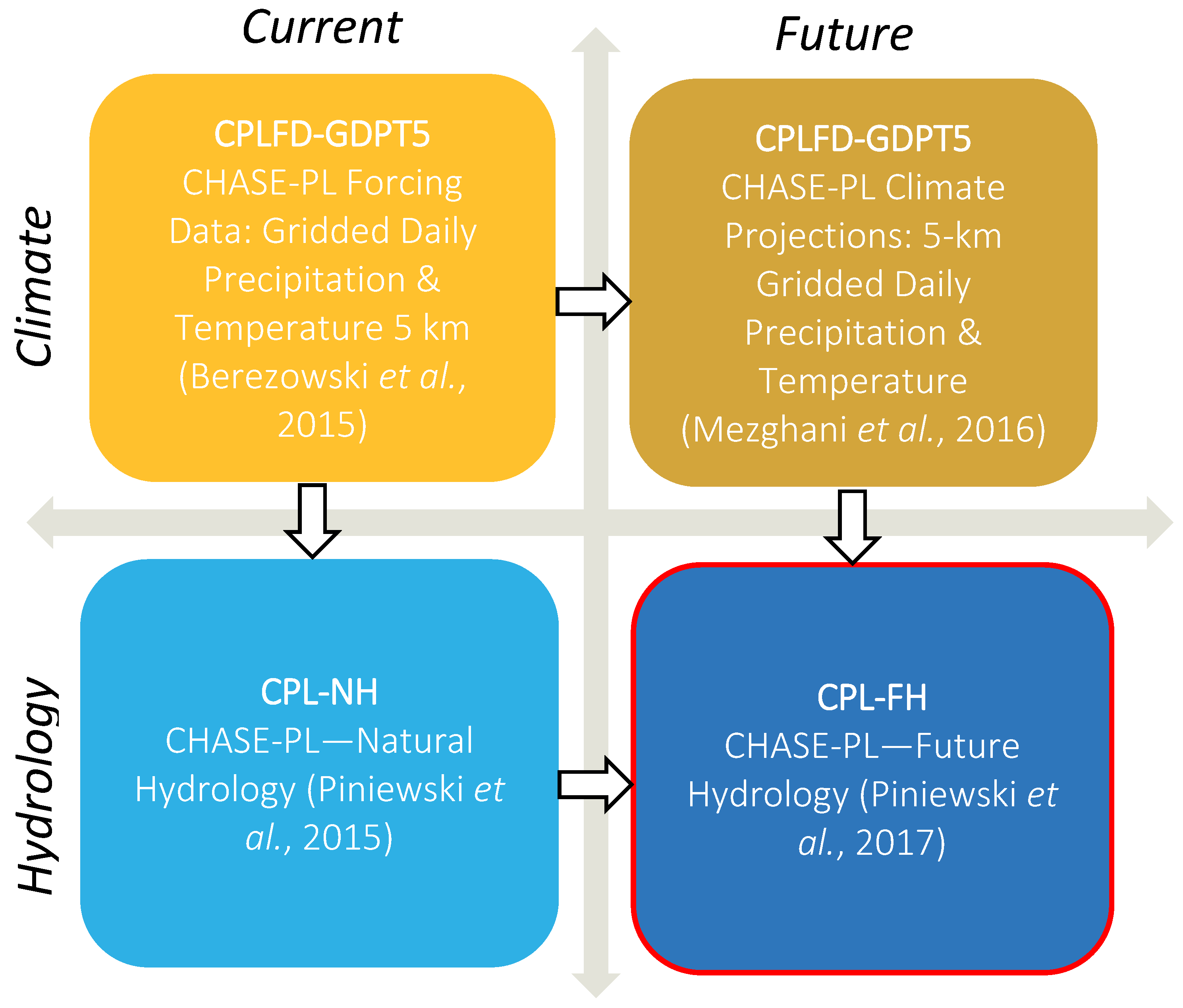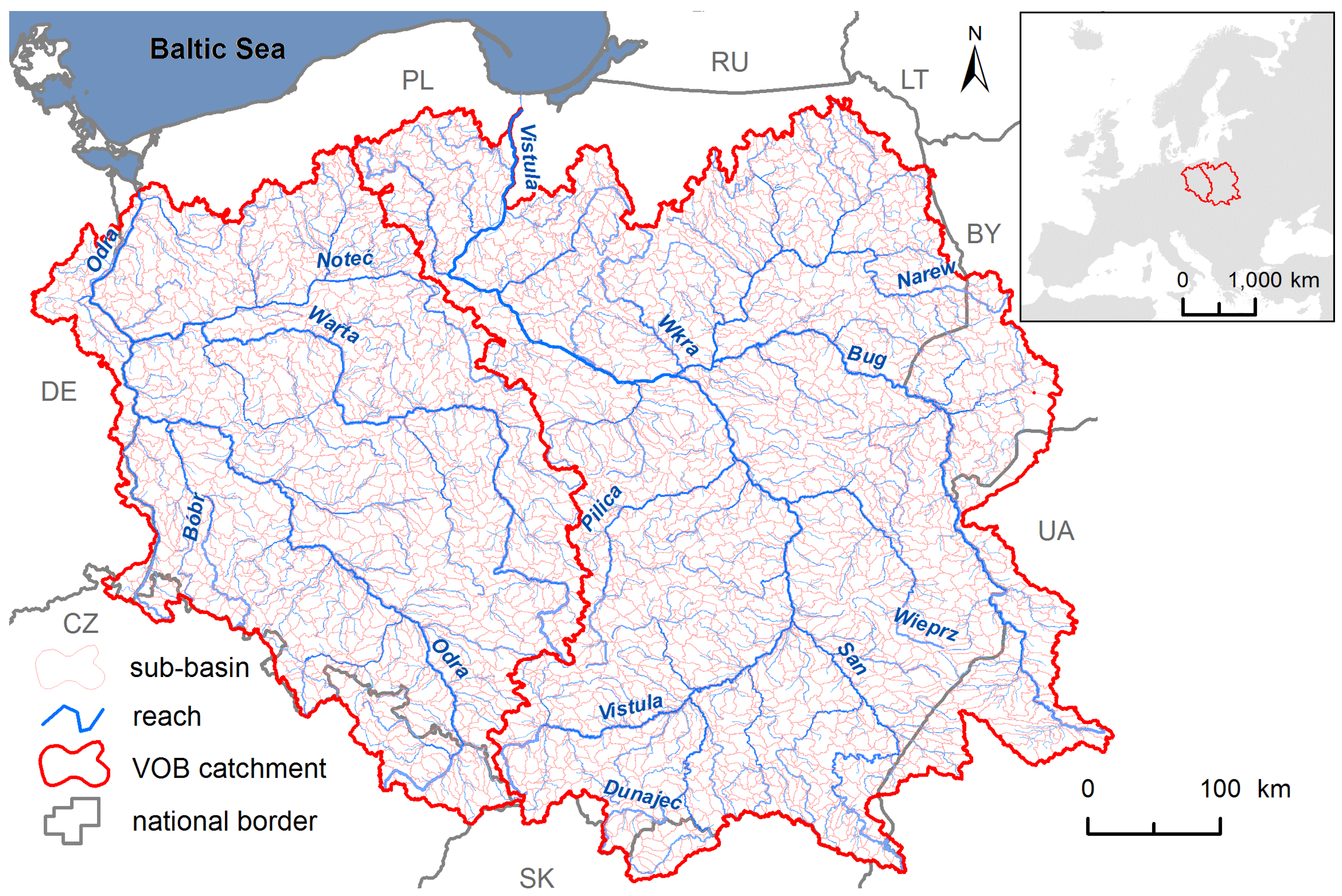CHASE-PL—Future Hydrology Data Set: Projections of Water Balance and Streamflow for the Vistula and Odra Basins, Poland
Abstract
:1. Summary
2. Data Description
2.1. Model inputs
- R can be “ref”, meaning reference. “rcp45” or “rcp85” meaning different Representative Concentration Pathways, RCP 4.5 and RCP 8.5, respectively;
- cmZ—defined GCM-run-RCM combination, where Z refers to the codes from Table 1.
- YYYY-YYYY defines the beginning and ending year of the simulation period, i.e., either 1971–2000, or 2021–2050, or 2071–2100.
2.2. Raw Model Outputs
- The calibrated and validated SWAT model run for the historical period 1954–2013 (cf. [14]);
- Model runs forced with nine different bias-corrected RCM data (cf. Section 3) for the reference period 1974-2000 (Ref);
- Model runs forced with nine different RCM data under RCP 4.5 for the near future (NF), i.e., 2024–2050;
- Model runs forced with nine different RCM data under RCP 8.5 for NF;
- Model runs forced with nine different RCM data under RCP 4.5 for the far future (FF), i.e., 2074–2100;
- Model runs forced with nine different RCM data under RCP 8.5 for FF.
- R can be “ref”, meaning reference. “rcp45” or “rcp85” meaning different Representative Concentration Pathways, RCP 4.5 and RCP 8.5, respectively;
- cmZ—defined GCM-run-RCM combination, where Z refers to the codes from Table 1.
- YYYY-YYYY defines the beginning and ending year of the simulation period, i.e., either 1974–2000, or 2024–2050, or 2074–2100.
2.3. Aggregated Model Outputs
- R can be “rcp45” or “rcp85” meaning different Representative Concentration Pathways, RCP 4.5 and RCP 8.5, respectively;
- YYYY-YYYY defines the beginning and ending year of the future projection horizon, i.e., 2024–2050, or 2074–2100 (note that three first years are truncated).
3. Methods
3.1. Calibrated SWAT Model
3.2. Climate Projections
3.3. Uncertainty
4. User Notes
4.1. Model Execution
4.2. Post-Processing of Model Outputs
- By selecting sub-basin numbers from the subbasins.shp file based on a query in the GIS software (e.g., QGIS);
- By connecting a table SubbasinDomainLev3.csv (located in RawModelOutputs.zip) to the database. This coded domain table stores geographical names of the rivers based on the Map of Hydrographical Division of Poland (MPHP 2012). Three highest Strahler [26] stream orders are included, e.g., Wisła/Narew/Biebrza.
Supplementary Materials
Acknowledgments
Author Contributions
Conflicts of Interest
Abbreviations
| .csv | comma-separated values file |
| 95PPU | 95 percent prediction uncertainty |
| Ann | annual |
| CEE | Central and Eastern Europe |
| CHASE-PL | Climate Change Impact Assessment for Selected Sectors in Poland |
| CPLCP-GDPT5 | CHASE-PL Climate Projections—Gridded Daily Precipitation and Temperature 5 km data set |
| CPLFD-GDPT5 | CHASE-PL Forcing Data—Gridded Daily Precipitation and Temperature 5 km data set |
| CPL-FH | CHASE-PL—Future Hydrology data set |
| CPL-NH | CHASE-PL—Natural Hydrology |
| DJF | winter |
| FF | far future |
| GCM | General Circulation Models |
| GHG | greenhouse gas |
| GIS | Geographic Information System |
| HRU | Hydrologic Response Units |
| ISIMIP | Inter-sectoral Impact Model Intercomparison Project |
| JJA | summer |
| KGE | Kling-Gupta Efficiency |
| MAM | spring |
| NF | near future |
| PET | potential evapotranspiration |
| RCM | Regional Climate Models |
| SCS | Soil Conservation Service |
| SON | autumn |
| SUFI-2 | Sequential Uncertainty Fitting version 2 |
| SWAT | Soil&Water Assessment Tool |
| U.K. | United Kingdom |
| USDA | United States Department of Agriculture |
| VOB | Vistula and Odra basins |
References
- Kundzewicz, Z.; Ulbrich, U.; Brücher, T.; Graczyk, D.; Krüger, A.; Leckebusch, G.; Menzel, L.; Pińskwar, I.; Radziejewski, M.; Szwed, M. Summer Floods in Central Europe—Climate Change Track? Nat. Hazards 2005, 36, 165–189. [Google Scholar] [CrossRef]
- Prudhomme, C.; Haxton, T.; Crooks, S.; Jackson, C.; Barkwith, A.; Williamson, J.; Kelvin, J.; Mackay, J.; Wang, L.; Young, A.; et al. Future Flows Hydrology: An ensemble of daily river flow and monthly groundwater levels for use for climate change impact assessment across Great Britain. Earth Syst. Sci. Data 2013, 5, 101–107. [Google Scholar] [CrossRef]
- Berezowski, T.; Szcześniak, M.; Kardel, I.; Michałowski, R.; Okruszko, T.; Mezghani, A.; Piniewski, M. CPLFD-GDPT5: High-resolution gridded daily precipitation and temperature data set for two largest Polish river basins. Earth Syst. Sci. Data 2016, 8, 127–139. [Google Scholar] [CrossRef]
- Berezowski, T.; Piniewski, M.; Szcześniak, M.; Kardel, I. CHASE-PL Forcing Data: Gridded Daily Precipitation & Temperature Dataset 5 km (CPLFD-GDPT5). 2015. Available online: https://doi.org/10.4121/uuid:e939aec0-bdd1-440f-bd1e-c49ff10d0a07 (accessed on 19 April 2017).
- Piniewski, M.; Szcześniak, M.; Kardel, I.; Berezowski, T. CHASE-PL—Natural Hydrology Dataset (CPL-NH). 2015. Available online: https://doi.org/10.4121/uuid:b8ab4f5f-f692-4c93-a910-2947aea28f42 (accessed on 19 April 2017).
- Piniewski, M.; Szcześniak, M.; Kardel, I.; Berezowski, T.; Okruszko, T.; Srinivasan, R.; Vikhamar-Schuler, D.; Kundzewicz, Z.W. Hydrological modelling of the Vistula and Odra river basins using SWAT. Hydrol. Sci. J. 2017. accepted. [Google Scholar]
- Mezghani, A.; Dobler, A.; Haugen, J. CHASE-PL Climate Projections: 5-km Gridded Daily Precipitation & Temperature Dataset (CPLCP-GDPT5). 2016. Available online: https://doi.org/10.4121/uuid:e940ec1a-71a0-449e-bbe3-29217f2ba31d (accessed on 19 April 2017).
- Piniewski, M.; Mezghani, A.; Szcześniak, M.; Kundzewicz, Z. Regional projections of temperature and precipitation changes: Robustness and uncertainty aspects. Meteorol. Z. 2017. [Google Scholar] [CrossRef]
- Arnold, J.G.; Srinivasan, R.; Muttiah, R.S.; Williams, J.R. Large area hydrologic modeling and assessment part I: Model development. J. Am. Water Resour. Assoc. 1998, 34, 73–89. [Google Scholar] [CrossRef]
- Ficklin, D.L.; Luo, Y.; Luedeling, E.; Zhang, M. Climate change sensitivity assessment of a highly agricultural watershed using {SWAT}. J. Hydrol. 2009, 374, 16–29. [Google Scholar] [CrossRef]
- Krysanova, V.; Srinivasan, R. Assessment of climate and land use change impacts with SWAT. Reg. Environ. Chang. 2015, 15, 431–434. [Google Scholar] [CrossRef]
- Marcinkowski, P.; Piniewski, M.; Kardel, I.; Gielczewski, M.; Okruszko, T. Modelling of discharge, nitrate and phosphate loads from the Reda catchment to the Puck Lagoon using SWAT. Ann. Warsaw Univ. Life Sci. SGGW Land Reclama. 2013, 45, 125–141. [Google Scholar] [CrossRef]
- Piniewski, M.; Okruszko, T. Multi-Site Calibration and Validation of the Hydrological Component of SWAT in a Large Lowland Catchment. In Modelling of Hydrological Processes in the Narew Catchment; Świątek, D., Okruszko, T., Eds.; Geoplanet: Earth and Planetary Sciences; Springer: Berlin/Heidelberg, Germany, 2011; pp. 15–41. [Google Scholar]
- Piniewski, M.; Szcześniak, M.; Huang, S.; Kundzewicz, Z. Projections of runoff in the Vistula and the Odra river basins with the help of the SWAT Model. Hydrol. Res. 2017. accepted. [Google Scholar]
- Piniewski, M.; Szcześniak, M.; Kundzewicz, Z.W.; Mezghani, A.; Hov, Ø. Changes in low and high flows in the Vistula and the Odra basins: model projections in the European-scale context. Hydrol. Processes 2017. accepted. [Google Scholar] [CrossRef]
- Piniewski, M.; Meresa, H.; Romanowicz, R.; Osuch, M.; Szcześniak, M.; Kardel, I.; Okruszko, T.; Mezghani, A.; Kundzewicz, Z. What can we learn from the projections of changes of flow patterns? Results from Polish case studies. Acta Geophys. 2017. under review. [Google Scholar]
- Neitsch, S.; Arnold, J.; Kiniry, J.; Williams, J. Soil and Water Assessment Tool Theoretical Documentation, Version 2009; Technical Report TR-406; Texas A&M University: College Station, TX, USA, 2011. [Google Scholar]
- Mathews, R.; Richter, B.D. Application of the Indicators of Hydrologic Alteration Software in Environmental Flow Setting1. JAWRA J. Am. Water Resour. Assoc. 2007, 43, 1400–1413. [Google Scholar] [CrossRef]
- Gupta, H.V.; Kling, H.; Yilmaz, K.K.; Martinez, G.F. Decomposition of the mean squared error and NSE performance criteria: Implications for improving hydrological modelling. J. Hydrol. 2009, 377, 80–91. [Google Scholar] [CrossRef]
- He, Y.; Bárdossy, A.; Zehe, E. A review of regionalisation for continuous streamflow simulation. Hydrol. Earth Syst. Sci. 2011, 15, 3539–3553. [Google Scholar] [CrossRef]
- Sellami, H.; La Jeunesse, I.; Benabdallah, S.; Baghdadi, N.; Vanclooster, M. Uncertainty analysis in model parameters regionalization: A case study involving the SWAT model in Mediterranean catchments (Southern France). Hydrol. Earth Syst. Sci. 2014, 18, 2393–2413. [Google Scholar] [CrossRef]
- Gudmundsson, L.; Bremnes, J.B.; Haugen, J.E.; Engen-Skaugen, T. Technical Note: Downscaling RCM precipitation to the station scale using statistical transformations – a comparison of methods. Hydrol. Earth Syst. Sci. 2012, 16, 3383–3390. [Google Scholar] [CrossRef]
- Wilby, R.L.; Dessai, S. Robust adaptation to climate change. Weather 2010, 65, 180–185. [Google Scholar] [CrossRef]
- Carter, T.; Hulme, M. Key Findings from the First ECLAT-2 workshop “Representing Uncertainties in Climate Change Scenarios and Impact Studies”. In ECLAT-2 Workshop Report No. 2; Cramer, W., Doherty, R., Hulme, M., Viner, D., Eds.; Climatic Research Unit, UEA: Norwich, UK, 2000; pp. 10–14. [Google Scholar]
- Teutschbein, C.; Seibert, J. Regional Climate Models for Hydrological Impact Studies at the Catchment Scale: A Review of Recent Modeling Strategies: Regional climate models for hydrological impact studies. Geogr. Compass 2010, 4, 834–860. [Google Scholar] [CrossRef]
- Strahler, A. Quantitative analysis of watershed geomorphology. Trans. Am. Geophys. Union 1957, 38, 913. [Google Scholar] [CrossRef]


| Code | GCM | RCM | Institute |
|---|---|---|---|
| 01 | CNRM-CERFACS-CNRM-CM5 | CLMcom-CCLM4-8-17 | CLMcom |
| 02 | CNRM-CERFACS-CNRM-CM5 | SMHI-RCA4 | SMHI |
| 03 | ICHEC-EC-EARTH | CLMcom-CCLM4-8-17 | CLMcom |
| 04 | ICHEC-EC-EARTH | SMHI-RCA4 | SMHI |
| 05 | ICHEC-EC-EARTH | KNMI-RACMO22E | KNMI |
| 06 | ICHEC-EC-EARTH | DMI-HIRHAM5 | DMI |
| 07 | IPSL-IPSL-CM5A-MR | SMHI-RCA4 | SMHI |
| 08 | MPI-M-MPI-ESM-LR | CLMcom-CCLM4-8-17 | CLMcom |
| 09 | MPI-M-MPI-ESM-LR | SMHI-RCA4 | SMHI |
| Variable Code | Output File | Description | Units |
|---|---|---|---|
| PCP | .sub | Total amount of precipitation falling on the sub-basin during time step | mm |
| SNOM | .sub | Amount of snow or ice melting during time step (water-equivalent) | mm |
| PET | .sub | Potential evapotranspiration from the sub-basin during time step | mm |
| ET | .sub | Actual evapotranspiration from the subbasin during time step | mm |
| SW | .sub | Soil water content—amount of water in the soil profile at the end of the time period. | mm |
| PERC | .sub | Water that percolates past the root zone during the time step (mm). There is potentially a lag between the time the water leaves the bottom of the root zone and reaches the shallow aquifer. Over a long period of time, this variable should equal groundwater percolation. | mm |
| SURQ | .sub | Surface runoff contribution to streamflow during time step | mm |
| GWQ | .sub | Groundwater contribution to streamflow. Water from the shallow aquifer that returns to the reach during the time step | mm |
| WYLD | .sub | Water yield. The net amount of water that leaves the subbasin and contributes to streamflow in the reach during time step | mm |
| FLOW | .rch | Natural discharge of water in the reach | m s |
© 2017 by the authors. Licensee MDPI, Basel, Switzerland. This article is an open access article distributed under the terms and conditions of the Creative Commons Attribution (CC BY) license (http://creativecommons.org/licenses/by/4.0/).
Share and Cite
Piniewski, M.; Szcześniak, M.; Kardel, I. CHASE-PL—Future Hydrology Data Set: Projections of Water Balance and Streamflow for the Vistula and Odra Basins, Poland. Data 2017, 2, 14. https://doi.org/10.3390/data2020014
Piniewski M, Szcześniak M, Kardel I. CHASE-PL—Future Hydrology Data Set: Projections of Water Balance and Streamflow for the Vistula and Odra Basins, Poland. Data. 2017; 2(2):14. https://doi.org/10.3390/data2020014
Chicago/Turabian StylePiniewski, Mikołaj, Mateusz Szcześniak, and Ignacy Kardel. 2017. "CHASE-PL—Future Hydrology Data Set: Projections of Water Balance and Streamflow for the Vistula and Odra Basins, Poland" Data 2, no. 2: 14. https://doi.org/10.3390/data2020014






